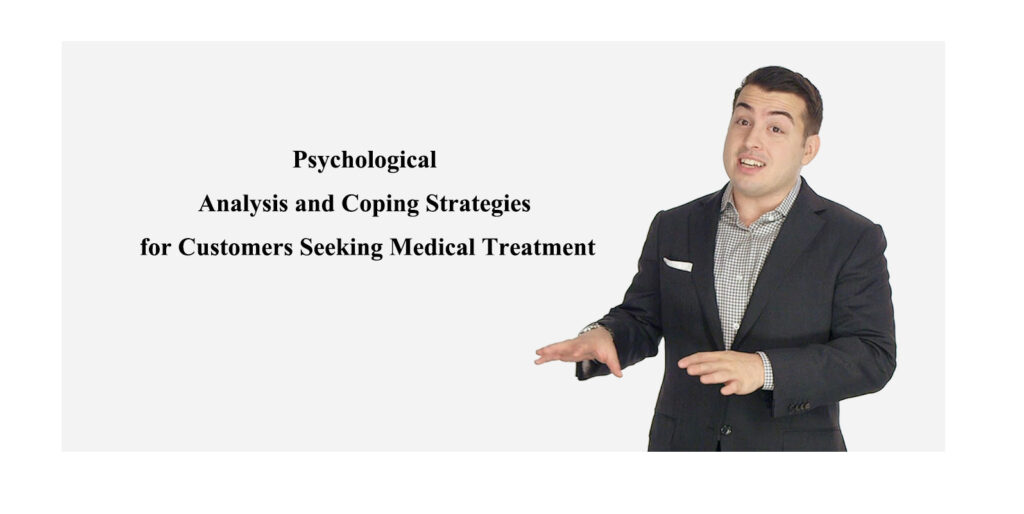
The article discusses six common psychological aspects of customers seeking medical treatment:
Fear Psychology:
*Fear of dental pain: To address customers’ fear of dental pain, doctors need to provide exquisite techniques and painless treatment while addressing customers’ psychological needs. If painless treatment can be achieved, I believe customers will definitely become your loyal fans.
*Fear of infection: When customers seek medical treatment, they may initially fear pain and disease transmission, as well as worry about doctor-patient relationships and technical risks.
In terms of disease transmission, doctors need to create a sterile environment and pay attention to details such as wearing masks and gloves to enhance customers’ trust.
*Fear of being deceived: For example, when we go to a beauty salon or hair salon, a hair washing assistant may indirectly suggest dyeing our hair if they mention that our hair looks yellow. We know what they are trying to do, either suggesting dyeing our hair or selling us related hair care products.
*Fear of technical flaws: For example, if the treatment time is not very long, can we present cases of successful treatments to explain to them? At this point, it is easy to establish trust quickly by generating resonance.
Guarded Psychology: Customers may develop guarded psychology during initial contact, so it is necessary to establish trust through careful communication and professional attitude. For customers’ guarded psychology, doctors need to communicate sincerely and without pressure to avoid being seen as only focusing on profit.
Comparative Psychology: In response to customers’ comparative psychology, doctors need to understand customers’ needs and expectations and provide ideal treatment plans to reduce comparisons and hesitations. Customers often compare different options and make choices based on their needs and budgets. Provide multiple options and introduce their value and advantages.
For example, when we go shopping, we might enter the first store, try on a piece of clothing, check its color, style, fabric, and price, all of which meet our standards or expectations. Why don’t we make a decision and buy it immediately? Of course, because we want to compare, maybe there are cheaper or better-looking options elsewhere. So, in clinical practice, especially for major clients and projects, they tend to compare, considering that the initial cost may be higher and there may be risks, which is understandable.
Authority Psychology: Customers tend to choose medical institutions or doctors with stronger authority, so it is necessary to demonstrate professionalism and authority.
For example, when we go to see a dentist, why do we sometimes go to public hospitals? What does a public hospital mean? It may mean that it is more reliable than private hospitals, and public hospitals have more experts and are more standardized. So why do you look for acquaintances or experienced experts? Because you need solutions, you need to solve your illness and psychological needs, so at this point, you seek authority. So how do we establish our authority in our work? On the one hand, when we do external marketing, we must emphasize our authority as experts.
Herd Psychology: Customers may be influenced by the behavior of others and tend to choose options recognized by others.
Let’s take dental implants as an example. They are already popular, not to mention developed countries, just in our first-tier cities. In our local area, within the next 3 to 5 years, they will definitely become popular because why? Dental implants are the best and most ideal solution for dental restoration. Of course, currently, many customers with certain consumption capabilities and conditions will choose dental implants. This captures the psychology of conformity.
Middle-ground Psychology: Customers often choose options of medium price or service rather than the most expensive or cheapest.
For example, McDonald’s, KFC. If you ask their front desk, which size of cola sells the most, the survey results will definitely show that the medium size sells the most. People often choose neither the most expensive nor the cheapest option, but often choose the middle one. If conditions permit, they will tend to choose slightly higher ones.
Analysis of Modern Dental Patients’ Visiting Behavior. Generally, there are four stages:
The first is the generation of demand, such as yesterday when their teeth were not painful, but today they woke up in the middle of the night with toothache and didn’t sleep well.
Then they plan to go to the dentist tomorrow, which is another situation they generated themselves. For aesthetic customers, for example, when they see advertisements or colleagues getting dental work done and saying, “Wow, it looks beautiful,” they will want to go have their teeth checked. At this time, when they are not very clear about major projects and their problems are not very urgent, what will they do? They will first compare and gather information, then what?
The second step is to gather information, which is often done by using their mobile phones because it’s convenient. They will search on their phones, “What is orthodontics? How much does it cost? How long will it take?” and so on. Then, they will ask around among their family and friends or seek recommendations locally. This is the second step, gathering information.
The third step is to physically compare, where customers will typically choose about three institutions to compare. Although the first institution they visit might be ours, if they have a very good experience there, we might be the first to set a standard in their minds. Then they will take our standard to compare with the second institution. If they have compared two institutions, at this point, before the consultation, we need to chat with them, talk about their needs, ask if they have had their teeth checked elsewhere, what was it like, what’s the treatment plan, how much does it cost roughly, can they afford it, and so on. We need to comprehensively understand this information as much as possible because the more comprehensive our understanding, the more efficient our consultation will be. This is the fourth, third step, physically comparing.
After comparing, what will they do?
To the fourth step, decision-making. Where is the better place for dental care? Which institution would be better? Which doctor is more professional and authoritative? At this point, they will comprehensively compare and then choose which institution to go to.


